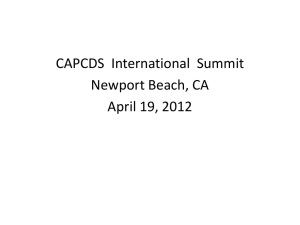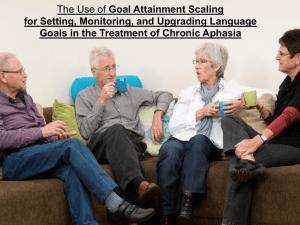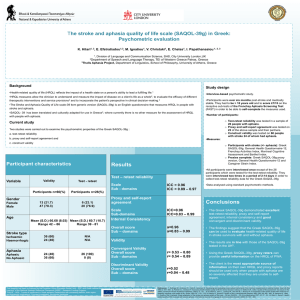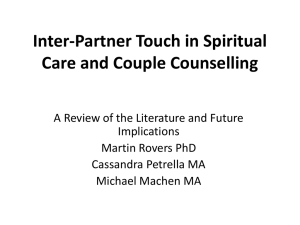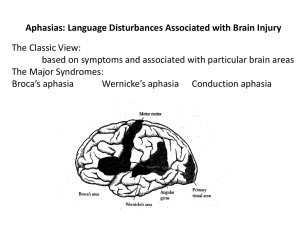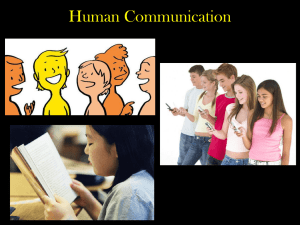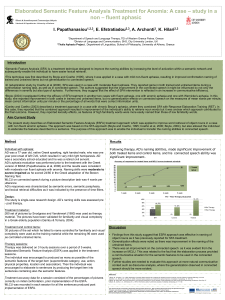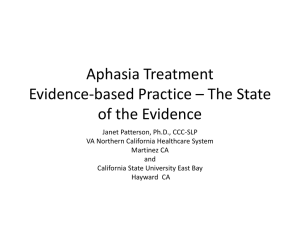EFT & Aphasia (1) - Neuroscienze.net
advertisement
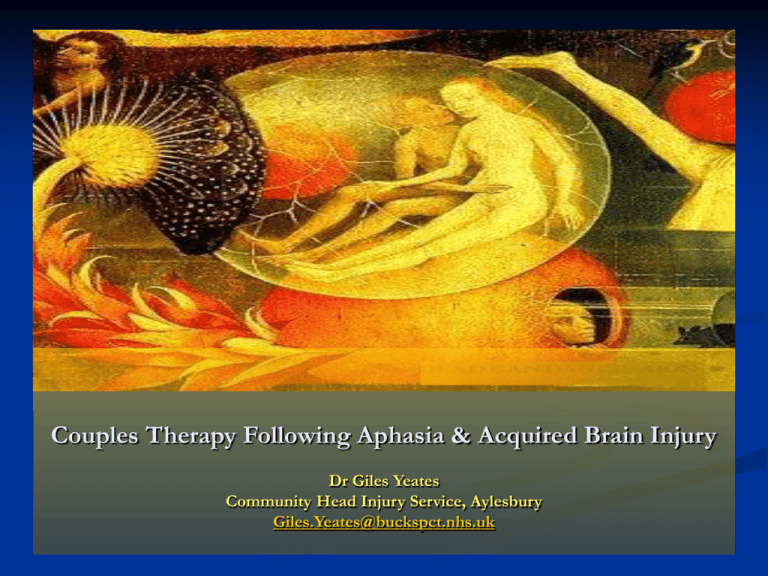
Couples Therapy Following Aphasia & Acquired Brain Injury Dr Giles Yeates Community Head Injury Service, Aylesbury Giles.Yeates@buckspct.nhs.uk Reflecting on Our Own Aphasia within Our Relationships In Our Intimate Relationships: In Our Therapeutic Relationships: When it no longer feels worthwhile to say more, to try to reach out and reconnect, hopelessness When it doesn’t feel safe to try and risk reconnecting, for fear of getting it wrong again When communication with clients with aphasia feels so effortful, against the odds, that meaningful conversations are not attempted In Our Professional Team Communications: When therapeutic opportunities are not explored in team thinking-throughconversation, due to assumptions of clients’ ability The Elephant in the Room in NeuroRehab sessions…. Loss of empathic connection between survivors of brain injury and those around them Withdrawal, disconnection, and/or intrusion, insensitivity A distressing priority for relatives, mostly likely resulting in resigned, impotent responses by clinicians Juxtapose the need for an ‘interdependence’ rehab goal in contrast to typical goals for independence Aphasia as Identity & Relationship Theft Aphasia & Couples Aphasia as Identity Theft (Shadden, 2005 ) Robbing cherished selves from partners This loss disturbing sense of self in non-injured partner (Yeates, 2013) Sabat & Harré (1992) Discourse analysis of interactional loss of social self following dementia language difficulties Aphasia & Couples Outcomes: Association between post-stroke aphasia and marital satisfaction of partner, the latter lower than wives of non-aphasic stroke survivors (Łapkiewicz et al., 2008; Williams, 1993; Williams & Freer, 1986) But mixed evidence on association between aphasia severity and marital satisfaction Wives’ perception of aphasia severity a key moderator, related to level of nurturance provided & independent of survivor communication performance (Buxbaum, 1967) Difficulties in Social Cognition/Pragmatic Communication & Couples Relationships (Yeates, 2013) Perspectival Intersubjective Space: Predicting/Decoding the mental states of others & appreciating different perspectives…. Works in tandem with attunement process Depends on network of medial frontal cortex, posterior superior temporal sulcus and temporal pole/?amygdala Theory of Mind/Mentalising & Perspective-Taking Deficits post injury (e.g., Frith, 2006 ; Rowe et al., 2001; Samson et al., 2007) “We-centric Intersubjective Space”: Aligning/attuning to others’ affective states • • Emotion Recognition & Affective Communication: • Simulation, Resonance or Contagion? • Involvement of anterior cingulate, amygdala, insula & somatosensory cortex • Emotion recognition & experiential deficits post injury: Fear, Anger & Disgust (see review by Goldman & Sripada, 2005) Closing the social loop through appropriate responding…. - Mainly involves orbito- and medial frontal cortex, also insula, amygdala & temporal poles, damage to which results in: - Accessing social knowledge (Channon & Crawford, 2000) - Making social judgements & using social norms (Milders et al., 2003) - Social Proxemics (Morris et al., 2007) - Social Reasoning (Stone et al., 2002) - Social problem solving (Grafman et al., 1996) - Affect regulation (Burgess & Wood, 1990) - Interoceptive-based decision making (Bechara et al., 1994; Damasio, 1994) Social Cognition Predictors of Couple Relationship Functioning (preliminary findings, n= 55) Survivor Neuropsychology Partner Psychosocial Variables Happiness Recognition TASIT EET Happy Mentalising Mind in Eyes Identification of Social Rule Violations Partner -Rated Relationship Variables .334 + - .272 Carer Strain DAS Total - .342 Physical Intimacy CSI - Dyadic Adjustment DAS AE + .219 Soc Sit Violations Demand-Withdraw Interactional Pattern Comm Q D-W Emotion Recognition TASIT EET + .152 Cohesion of Relationship DAS COH How to Help? A Case for A Relational Approach to Aphasia Rehabilitation ‘Skull Seduction’ after ABI (Yeates, 2007; 2011): Clinicians can perpetuate partition of clients & relatives in the literature by seeing couple separately, focusing mostly on survivor Acting exclusively as brain injury experts can perpetuate the focus on the damaged brain as a repository of all problems and only where the recovery takes place, limits the family’s options for change together Skye McDonald (2000): call of “let’s get social” in aphasiology, situated within relationships and social context ….& fetishising independence & autonomy Feeling versus thinking in Romantic Love: An opportunity in the heat of emotion? (Bartels & Zeki, 2004) Emotionally-Focused Couples Therapy (EFT) Core EFT Formulation Attachment Rupture Protest, Pursuing Abandonment: Anger/Anxiety Distancing, Withdrawing Criticised, Rejected, Confusion Anger/Anxiety/ Hopelessness Stages in EFT The process of change in EFT has been delineated in nine treatment steps: Cycle De-escalation Changing Interactional Positions. Step 1. Assessment-creating an alliance and explicating the core issues in the couple’s conflict using an attachment perspective. Step 2. Identifying the problem interactional cycle that maintains attachment insecurity and relationship distress. Step 3. Accessing the unacknowledged emotions underlying interactional positions. Step 4. Reframing the problem in terms of the cycle, the underlying emotions, and attachment needs. Step 5. Promoting identification with disowned needs and aspects of self and integrating these into relationship interactions. Step 6. Promoting acceptance of the partner’s new construction of experience in the relationship and new responses. Step 7. Facilitating the expression of specific needs and wants and creating emotional engagement. Consolidation/ Integration. Step 8. Facilitating the emergence of new solutions to old problematic relationship issues. Step 9. Consolidating new positions and new cycles of attachment behavior. EFT following ABI Anecdotal case reports: TBI: Chawla & Kafescioglu, 2012 Stroke - Stiell, Naaman & Lee, 2007; Stiell & Gailey, 2011 Single case quantitative systematic evaluations (Yeates et al., 2013) Couples Intervention: Reduce Partner Withdrawal, Amplification of Social Cues & Triggering Pro-Social Autonomic Response of Survivor EFT & Aphasia = first EFT paper in neuro literature Stiell & Gailey (2011): More recent book chapter expanding practice with aphasia Kathy Stiell, Director of Family Support Kathy is the co-founder of the Aphasia Centre of Ottawa and Director of Family Support. She has a Masters of Social Work from McGill University(1980) and is registered with the Ontario College of Certified Social Workers. Kathy is a clinical member of the Ontario Association of Marriage and Family Therapists and a certified therapist and supervisor in Emotionally Focused Therapy. She has provided leadership in making individual, couple and family counselling accessible to people living with aphasia Following Aphasia… Attachment Rupture Survivor: Imposed Withdrawal - Criticised, Rejected - Confusion - Anger/Frustration/Anxiet/ Hopelessness Partner: Progressive Withdrawal - Loss of confidence in abilities - Ignored by survivor-focused rehab - Unacknowledged experience -Abandonment: Anger/Anxiety EFT & Aphasia (1): Creation of A Communication Platform Use facilitative communication strategies, technology and compensatory cognitive strategies to enable functional communication of content But essential provide an emotionally-safe attachment base in the therapy room to: allow survivor and partner to risk reaching out enable mutual understanding try again where previously failed and hurt Example from Stiell & Gailey (2011) Jane Roger Laura EFT & Aphasia (2): Supporting Pro-Nurturing Couples Interactions Externalising aphasia as a thief and intruder into the relationship, a common adversary of the couple (Shadden, 2005; White & Epston, 1990) RISSSC (Johnson, 2004): Repeat, Imagery, Soft, Slow, Simple, Client’s Words In-Session Enactments: reaching from vulnerability Deconstructing survivor’s anger and partner’s feeling of rejection Roger Jane Levels of Joy “This dialogue was a turning point for Jane and helped her moved out of a withdrawn position in the cycle. She was able to share her underlying fear of being a failure as a caregiver. This fear became acute when she could not make Roger happy and she wondered if they would ever be happy again as a couple. Recognising Roger’s inability to initiate conversations both therapists actively led him in giving feedback that direct addressed her attachment needs. Skillfully the two therapists worked together to facilitate a new conversation for the couple by tentatively suggesting that Roger could actively talked to Jane about sadness. The therapists encouraged Roger that it may not be so scary to reach for Jane and that he might not need to get so angry especially when he realised it pushed her away…. Jane’s ability to be in touch with Roger’s sadness restored her felt connection.” Conclusions: Interdependence is a legitimate rehab goal, desired by many survivors and partners Aphasia is not only a change in the communication potential for survivors, but potentially also a change to the very fabric of intimate interactions and selves of both survivors and partners This change is characterised by a loss of emotional safety, closeness and increased mutual withdrawal As clinicians we can support couples through opportunities to re-connect with support, using communication platforms to foster exchange of communication content and emotional security to reach out to one another Further Reading: Bowen, C., Yeates, G. N., & Palmer,S. (2010) A Relational Approach to Rehabilitation: Thinking about Relationships after Brain Injury. London: Karnac. Johnson, S. (2004). The Practice of Emotionally-Focused Couples Therapy. London: Routledge Shadden, B. (2005). Aphasia as identity theft: Theory and practice. Aphasiology, 19: 211-223. Stiell, K. & Gailey, G. (2011). Emotionally focused therapy for couples living with aphasia. In J.L., Furrow, S.M. Johnson & B.A. Bradley (Eds.), The Emotionally Focused Casebook (pp.113-140). New York, NY: Routledge. Yeates, G.N. (2013). Towards the neuropsychological foundations for couples therapy following acquired brain injury (ABI): A review of empirical evidence and relevant concepts. Neuro-Disability & Psychotherapy, 1(1), 117- 150. Yeates, G.N., Edwards, A., Murray, C. & Creamer, N. (2013). Couples therapy as social cognition intervention following acquired brain injury: Single case evaluations of emotionally-focused couples therapy (EFT). NeuroDisability & Psychotherapy 1(2), 151-194. www.iceeft.com (for Italian & international training)
